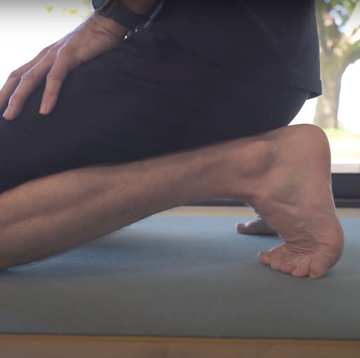The majority of people possess both anterior and posterior cruciate ligaments, which form an X-shaped structure through the middle of the joint, their function being to prevent fore and aft movement of the tibia on the femur. Injury, in the form of a rupture, may be due to an accident in everyday life, or as a result of sporting trauma. If a tear occurs, nine times out of 10 it will be in the anterior cruciate ligament (ACL).
Symptoms
You are likely to have twisted your knee pretty severely or bent it backwards in a dramatic fashion to tear your ACL. There is no question of carrying on in the majority of cases, as the knee gives way, becomes painful and will swell with blood on the day of injury. It will be difficult to walk on, let alone run.
Signs
Comparison with the other knee will allow your doctor to confirm the swelling of blood within the joint, and they may or may not draw this off before using other tests on the knee’s stability. When a knee is freshly swollen following injury, it is notoriously difficult to be sure of the exact diagnosis by simple examination, though tests to pull the tibia forward of the femur may be strongly positive if the excess fluid is first removed.
Medical investigations
X-rays are going to give scant help in demonstrating what is soft-tissue damage, though arthrography, in which the knee is filled with opaque fluid, will often be helpful. Scanning techniques, which have been refined over the last 20 years into a really effective diagnostic aid, have made X-rays largely redundant, though if an orthopaedic surgeon has any doubt about the injury, visualisation through arthroscopy will provide the ultimate proof.
Is ultra-running bad for the heart?
Any condition that fills a knee joint with fluid, be it blood or excess lubrication from the lining synovium must be considered in the differential diagnosis. The injury will limit movement of the knee, as may damage to the cartilages, the collateral ligaments that allow the joint to hinge, the patella, or the formation of a bursa. On occasions, even the most experienced surgeons have got the diagnosis wrong!
Self-treatment
Sometimes the ACL is merely stretched and becomes lax, rather than ruptured; sometimes the patient does not realise the severity of the injury and does not obtain treatment; and sometimes the knee settles down and you can return to sport. Part of the function of the ACL is replicated by the hamstring muscles, so if these are strong and you work hard to maintain power and tone, you might get away without surgery. It is said that six out of the 30 touring All-Black Rugby players last autumn did so without ACLs, though their hamstrings are reminiscent of the trunks of the Giant Sequoia!
Medical treatment
Twenty years ago ACL reconstruction was not really an option, but giant strides have been made in the use of human, animal and mineral substances to rebuild the ligament. Not only is the tissue used important, but the angle at which it is inserted is crucial, and the operation now resembles precision engineering to ensure that the biomechanical integrity of the joint is maintained. Rehabilitation under the watchful eye of a physiotherapist should ensure that a full range of movement is obtained and that those all-important hamstrings are developed to further support the artificial ACL.
Can you run through it?/Recovery time
ACL rupture is a severe trauma to the knee and even attempting to run through it invites the knee to give way and cause further damage to the menisci and articular cartilage. Luckily, it is likely to be far too painful for you even to attempt it, though even professional sportspeople should prepare for the best part of a year off if their ACLs need reconstruction.












